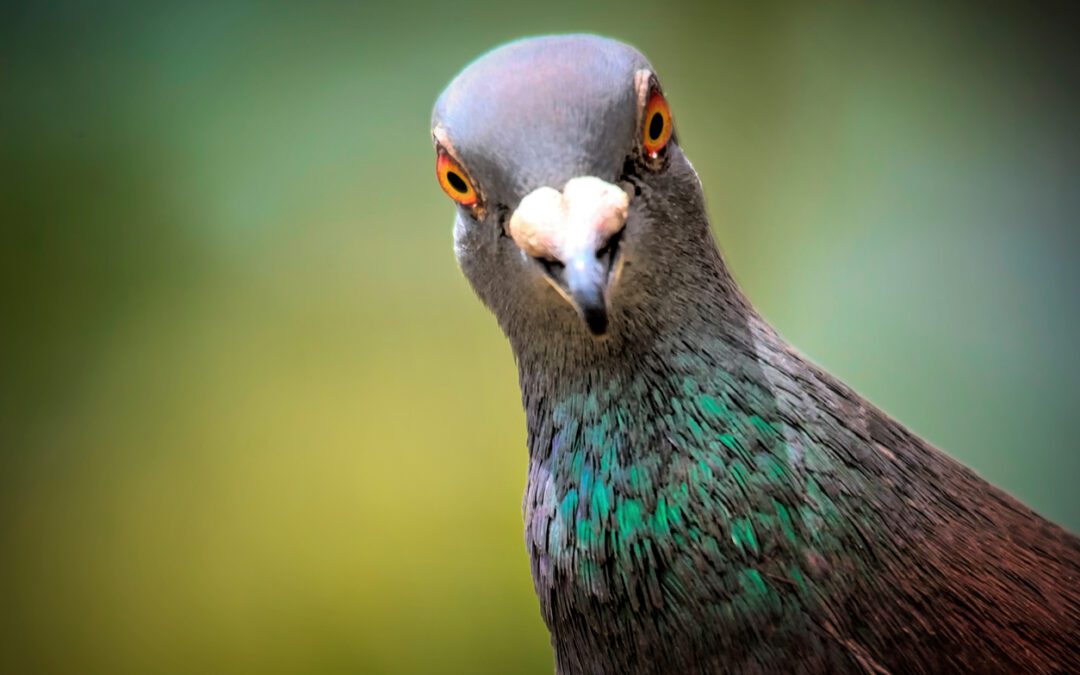I LIKE pigeons. Their voices are soft and rhythmic. I have put up baskets for them in the front verandah and they live there quietly. They don’t ask for food – probably because they are fed at the roundabout near my house by compassionate people who come from far to drop grains for them every day. I have a bird table of rice and fruit so they can feed there whenever they want.
The Mumbai Municipal Commissioner has made it the feature of his (hopefully brief) tenure that he will get rid of the pigeons from Mumbai. Those who go looking for something to hate and often pick on pigeons should know what they have done for us humans over the years.
The first airmail using pigeons was established in 1896 in New Zealand and was known as the Pigeon-Gram Service. Their speed averaged 77.6 mph, only 40% slower than a modern aircraft. Each pigeon carried 5 messages and special Pigeon-Gram stamps were sold for each message carried.
In the First World War, pigeons were used extensively for carrying messages. German marksmen were deployed to shoot the birds down. Pigeons were carried in tanks and released through tiny portholes in the side. Mine-sweeping boats carried pigeons so that in the event of an attack by a U-boat, a pigeon could be released with a message confirming the exact location of the sinking boat, often resulting in the crew being saved. Seaplanes carried pigeons to relay urgent information about enemy movements. In the Second World War, pigeons were used in active service in Europe, India and Burma.
The last pigeon messaging service in the world was in Odisha called Orissa Police Carrier Pigeon Service and it disbanded in 2006 after 60 years of active service and 800 birds. Carrier pigeons had provided daily communications between Orissa’s 400 police stations across the state. They carried essential messages during two natural disasters: the massive cyclone in 1971 and the unprecedented floods in 1982. Their ability to fly in adverse weather conditions saved many human lives.
Read Also
Impressive Voter Turnout In J&K Shows People’s Strong Trust In Democracy: Amit Shah
Influence Of Social Media On Golf’s Popularity In Post-Pandemic World
In the 5th century BC the first network of pigeon messengers is thought to have been established in Assyria and Persia by Cyrus the Great. In 2000 BC they were carrying messages to warring groups in Mesopotamia. In 53 B.C they carried Hannibal’s dispatches. Julius Caesar used pigeons during the conquest of Gaul from 58 to 51 BC. Indian and Arab merchants used carrier pigeons when visiting China. At the first Olympic Games held in 776 BC, every athlete had a homing pigeon from his village. If he won his event, his would be the bird that carried the news home.
Between 63 BC – AD 21, the Greek geographer Strabo noted that pigeons flew between certain points along the Mediterranean coastline to carry messages of the arrival of fish shoals for waiting fishermen.
The news agency Reuters originally used pigeons to disseminate news in the 1840s. Paul Julius Reuter’s pigeons only stopped when the telegram was invented. In 1870 they carried messages throughout France during the siege of Paris.
In 1915, at the start of the First Great War, two Pigeon Corps were established on the Western Front, consisting of 15 pigeon stations each with 4 birds and a handler. The Pigeon Corps was so successful that further birds were recruited, and the service expanded considerably. By the end of the war the Pigeon Corps consisted of 400 men and 22,000 pigeons in 150 mobile lofts. Messages would be put into a small canister and then attached to the pigeon’s leg. The bird would be released and would return to its loft behind allied lines, sounding a bell to confirm that it had landed. Each airfield along the coast of England had its own loft so that pigeons could be dispatched with messages in the event of invasion. Bomber crews usually carried a pair of pigeons so that in the event that the plane was shot down, the birds could be released with details of the crash site.
These birds played a major role in the Intelligence Service in the First World War. They were sent to maintain contact with resistance movements across Europe. Fewer than 10% survived the shell fire, small arms fire, poison gas.
In 1940, 300 crates of pigeons were dropped into Enemy-occupied areas of Europe, each bird being packed into a box with food for 10 days. Instructions and a questionnaire were put in the box. If found by an ally, information about enemy movement could be put inside the container on the bird’s leg and the bird released to fly back. 16,544 pigeons were parachuted into occupied Europe during the Second Great War. Only 1,842 returned.

Hand-drawn funny cute illustration – Curious pigeons.
Over 1,00,000 British pigeons lost their lives in military service. Red Cock flew back a torpedoed trawler carrying the grid reference of the sinking boat and saving the crew. In October 1918, 500 men of the 77th Infantry were trapped in Argonne, France with no food or ammunition and being bombarded by their own side. The major sent the pigeon Cher Ami with a message for rescue. The bird was shot through the breast by enemy fire and fell to the ground. She got back into the air and flew 25 miles back to Division Headquarters in 25 minutes. The men were saved. Cher Ami had delivered the message despite having been shot through the breast, blinded in one eye and with a leg hanging by only a tendon. The Dickin medal is awarded to any animal that has distinguished itself through an act of bravery in wartime. Of the 55 medals awarded to date, pigeons have been recognized 32 times- much less than they deserve because they saved the lives of lakhs of people. The American and Australian Services also used pigeons extensively and had their own pigeon units operating indifferent countries. So did Burma (Myanmar) and India.
Some years ago, the Indian army captured a pigeon carrying a message from the Pakistan army.
Pigeons were used for aerial photography. A miniature camera was mounted to the bird’s breast via a canvass harness and the pigeon sent to areas of strategic importance to capture images. The films provided information about enemy troop movements and air bases. Information relating to exact positions of the V1 flying bomb site in Peenemunde in Germany was conveyed by pigeons – information that turned the tide of the war.
In 2004 an impressive memorial to commemorate all the animals and birds killed during wartime was erected in Hyde Park. Pigeons have been given pride of place in the sculpture with two pack mules in the foreground weighed down with munitions and cannon parts.
Pigeons more than any other animal have been man’s best friend in times of crisis. They give of themselves for a just a handful of grain. You need to repay your debt every day.
Pigeon Patrol
Pigeon Patrol Products & Services is the leading manufacturer and distributor of bird deterrent (control) products in Canada. Pigeon Patrol products have solved pest bird problems in industrial, commercial, and residential settings since 2000, by using safe and humane bird deterrents with only bird and animal -friendly solutions. At Pigeon Patrol, we manufacture and offer a variety of bird deterrents, ranging from Ultra-flex Bird Spikes with UV protection, Bird Netting, 4-S Bird Gel and the best Ultrasonic and audible sound devices on the market today.
Canada’s top wholesaler for bird deterrent products for twelve consecutive years.
Contact us at 1- 877– 4– NO-BIRD, (604) 585-9279 or visit our website at https://www.pigeonpatrol.ca/
Bird Gone, Pigeon Gone, Pigeon problems, pigeon spikes, 1-877-4NO-BIRD, 4-S Gel, Bird Control, Pigeon Control, bird repellent, Bird Spikes, sonic bird repellent, stainless steel bird spikes, bird spikes Vancouver, Ultra Sonic Bird Control, Bird Netting, Plastic Bird Spikes, Canada bird spike deterrents, Pigeon Pests, B Gone Pigeon, Pigeon Patrol, pest controller, pest control operator, pest control technician, Pigeon Control Products, humane pigeon spikes, pigeon deterrents, pigeon traps, Pigeon repellents, Sound & Laser Deterrents, wildlife control, raccoon, skunk, squirrel deterrent, De-Fence Spikes, Dragons Den, Pigeon, Pigeon Patrol, Pigeons Roosting, Vancouver Pigeon Control, Bird Spikes, Bird Control, Bird Deterrent, Pigeon Deterrent, Surrey Pigeon Control, Pest, Seagull deterrent Vancouver Pigeon Blog, Birds Inside Home De-fence, Pigeon Nesting, Bird Droppings, Pigeon Dropping, woodpecker control, Keep The Birds Away, Birds/rats, seagull, pigeon, woodpecker, dove, sparrow, pidgeon control, pidgeon problem, pidgeon control, flying rats, pigeon Problems, bird netting, bird gel, bird spray, bird nails, bird guard, Pigeon control, Bird deterrents, Pigeon deterrents, Bird control, solutions, Pigeon prevention, Pigeon repellent, Bird proofing, Pest bird management, Pigeon spikes, Bird netting, Humane bird control, Bird exclusion, Urban bird control, Anti-roosting devices, Pigeon removal, Bird barriers

